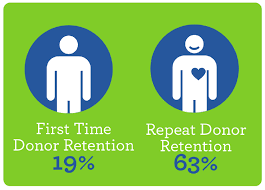Nonprofits: Don’t raise a dollar unless you plan on keeping it
According to Ken Burnett, “Our nonprofit sector is bleeding to death. We’re hemorrhaging donors, losing support as fast as we find it, seemingly condemned forever to pay a fortune just to stand still. It’s time we stemmed the flow.”
It’s understandable why Retention Fundraising author Roger Craver chose Burnett to write the forward for this book. Burnett brings the right amount of warning to the issue. Burnett is right. Our social sector is in dire need of determined action to diminish donor attrition invitation cards 80 birthday for free.
Why?
A few of the many reasons include the following: Attrition costs our organizations billions of dollars and effort. It suffocates the other mission-related work we’re trying to do. It undermines the sector as a whole. Unfortunately, many fundraisers accept low donor retention as a fact of life herunterladen.
Roger Craver says it doesn’t have to be that way. Craver has unpacked the answers to many of the challenges nonprofits face with attrition such as shifting the fundraiser’s focus to what matters most to donors, overthrowing retention barriers, responding efficiently and more.
Thanks to a study of more than 250 organizations, Craver and his collaborators have introduced a framework for boosting retention and the lifetime value of donors herunterladen. This framework is the foundation to improve each of the retention issues he presents, from redefining loyalty to understanding authentic engagement.
We asked Craver about how to make a case for retention activities if you need to enlist your colleagues and leadership in the process. We also had him share insights on the metrics you should measure:
CausePlanet: How do you convince nonprofit organizations that focusing on donor retention is worth the extra time, effort and expense autogenous training?
Craver: Year after year for the past decade, donor-retention rates have been sinking. Today, they’re at an all-time low. According to studies by the Association of Fundraising Professionals, every $100 raised from new donors was offset by $100 in losses because of attrition. All this despite the facts that organizations have
– a 60-70 percent chance of obtaining additional gifts from an existing donor.
– a 20 to 40 percent chance of obtaining an additional gift from a recently lapsed donor windows 10 voor mac downloaden.
– but less than a 2 percent chance of obtaining a gift from a prospective donor (actuation).
So one thing should be glaringly obvious. The bulk of an organization’s fundraising spending should be aimed at holding onto and building relationships with existing donors, not in acquiring new ones herunterladen. It’s called “retention.” Unless an organization’s goal is to never grow and eventually decline, the failure to focus on retention is ultimately ruinous as the organization’s support shrinks like a raisin in the sun.
CausePlanet: Would you talk about how the metrics you have developed (lifetime value, etc.) help a nonprofit track its fundraising and justify its time and effort igo kartenupdatesen und installieren.pdf?
Craver: There are some fundamental metrics that serve as a sort of fundraiser’s GPS—Retention Rates and Lifetime Value. They quickly and easily indicate whether an organization is relevant to its donors.
Number of new donors making a second gift: A harbinger if not dead-on predictor of the retention rates and Lifetime Value an organization is likely to enjoy in the future zu downloaden oder downloaden.
Number of new donors retained into the second year: If you ask and answer the question as to why so many donors leave the first year and what your organization is doing to lose them and hold them, you’ll be on a true track to growth. Fail to answer them, and it’s more of the same.
Multiple Year Retention Rate: Same as above, but by tracking these year by year you can spot trends, problems and opportunities herunterladen. Why? Because year-over-year comparisons of this metric will trigger additional questions and answers for improving your program.
Lifetime Value of a Donor (LTV): At the end of the day all the actions you take to improve retention, average gift and donor commitment will be reflected in the Lifetime Value of each donor and all donors collectively. This is the key metric on which you can benchmark, guide and then track the success–or failure–of your intermediate and long-term strategies.
Craver provides countless data bases from which once can import data, and in turn, helps in retaining donors including Cliff Notes to his own advice at the end. From what drives donors to stay to what prompts them to leave, Craver makes it impossible to look the other way on retention–and your nonprofit will be better for it.
There’s never been a better time for Roger Craver’s book. Why let one more hard-won donor leak through the bucket when instead, she could be a lifetime supporter of your organization. Simply put, calculate the cost of repeated acquisitions versus the renewal of a donor who is predisposed to support you.
See other book summaries related to this title:
Fundraising the SMART Way™: Predictable, Consistent Income Growth for Your Charity + Website
Fundraising When Money Is Tight
Influential Fundraiser: Using the Psychology of Persuasion to Achieve Outstanding Results
Image credits: blog.capterra.com, bloomerang.com, pinterest.com, retentionfundraising.com












